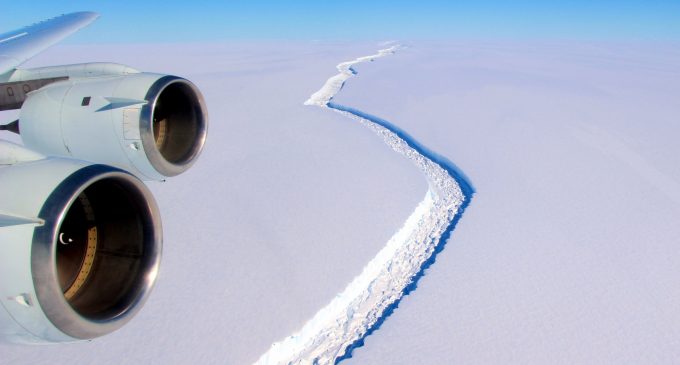
A gigantic iceberg has just broken off the Larsen C ice shelf in Antarctica and will begin floating north in the Atlantic Ocean. It’s as large as one of America’s smaller states (try to guess which one).
Some believe it is the third largest iceberg to break off the continent since satellite measurements became possible. But at this point, scientists are unable to pinpoint the exact path it might take.
The phenomenon of an iceberg forming off an ice shelf is known as “calving,” and the rift in the Larsen shelf that led to the latest iceberg began in 2010. Then, in 2016, it began growing rapidly.
No doubt hysterical climate change advocates will find a way to fit this normal event into their hyperventilated rhetoric. Scientists have tracked Antarctic icebergs since 1978 and have a continuous database that has tracked all the ones since 1999.
From June 1999 through April 2016 the track of each iceberg is available to analyze in order to determine a likely path for new icebergs.
Find out just how big the new iceberg is, where scientists think it could float and the possible impact the iceberg might have on ocean levels as it melts in warmer ocean currents. Details are on the next page.

You’ll notice that each and every time this ice breaks off from the Antarctic shelf, it’s always reported as being the size of Delaware. Weird, right? Not really. In fact, the reason why it’s always the same size is because that’s about the size it will be when it’s heavy and large enough to break off when there’s no more land beneath it to support it. You see, the glaciers inland in Antarctic (yes, it’s all land beneath that ice) will continue to grow and move outward toward the continental shelf. They will push outward for only so long as they can be supported. Eventually, the weight of it breaks off, because there’s nothing beneath it to support it. Happens all the time. It’s completely normal. You’ll never hear this happening in the north as the Arctic ice is not sitting on land, but on the ocean. Sometimes, large chunks break off, but by meters, not miles. It’s just common sense, but they’ll just yell Global Warming, as usual.
Ice doesn’t weaken with time. In fact, if under pressure it will get denser and stronger as air bubbles are pushed out.
I heard a climate scientist on the radio when they asked him why this happened and if it was related to global warming and he said no this is just what iceshelves do, they grow so big get so heavy break off and make icebergs. He said the rapid expansion of the ice over the last few years has caused the grow so big that it broke off.